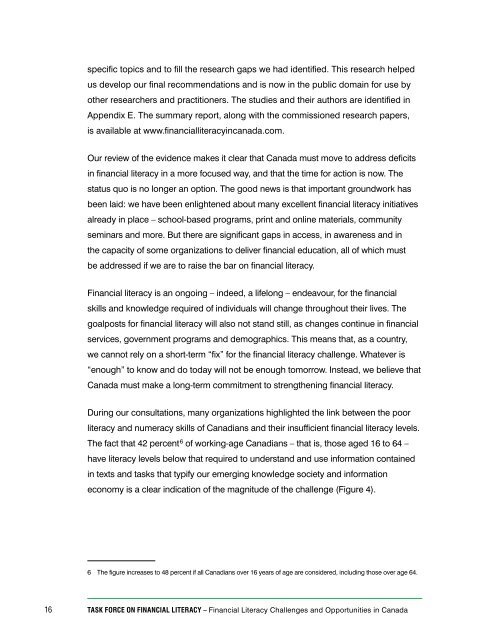Canadians and Their Money
Canadians and their money: building a brighter financial - EduGAINS
Canadians and their money: building a brighter financial - EduGAINS
- No tags were found...
Create successful ePaper yourself
Turn your PDF publications into a flip-book with our unique Google optimized e-Paper software.
specific topics <strong>and</strong> to fill the research gaps we had identified. This research helpedus develop our final recommendations <strong>and</strong> is now in the public domain for use byother researchers <strong>and</strong> practitioners. The studies <strong>and</strong> their authors are identified inAppendix E. The summary report, along with the commissioned research papers,is available at www.financialliteracyincanada.com.Our review of the evidence makes it clear that Canada must move to address deficitsin financial literacy in a more focused way, <strong>and</strong> that the time for action is now. Thestatus quo is no longer an option. The good news is that important groundwork hasbeen laid: we have been enlightened about many excellent financial literacy initiativesalready in place – school-based programs, print <strong>and</strong> online materials, communityseminars <strong>and</strong> more. But there are significant gaps in access, in awareness <strong>and</strong> inthe capacity of some organizations to deliver financial education, all of which mustbe addressed if we are to raise the bar on financial literacy.Financial literacy is an ongoing – indeed, a lifelong – endeavour, for the financialskills <strong>and</strong> knowledge required of individuals will change throughout their lives. Thegoalposts for financial literacy will also not st<strong>and</strong> still, as changes continue in financialservices, government programs <strong>and</strong> demographics. This means that, as a country,we cannot rely on a short-term “fix” for the financial literacy challenge. Whatever is“enough” to know <strong>and</strong> do today will not be enough tomorrow. Instead, we believe thatCanada must make a long-term commitment to strengthening financial literacy.During our consultations, many organizations highlighted the link between the poorliteracy <strong>and</strong> numeracy skills of <strong>Canadians</strong> <strong>and</strong> their insufficient financial literacy levels.The fact that 42 percent 6 of working-age <strong>Canadians</strong> – that is, those aged 16 to 64 –have literacy levels below that required to underst<strong>and</strong> <strong>and</strong> use information containedin texts <strong>and</strong> tasks that typify our emerging knowledge society <strong>and</strong> informationeconomy is a clear indication of the magnitude of the challenge (Figure 4).6 The figure increases to 48 percent if all <strong>Canadians</strong> over 16 years of age are considered, including those over age 64.16TASK FORCE ON FINANCIAL LITERACY – Financial Literacy Challenges <strong>and</strong> Opportunities in Canada
















